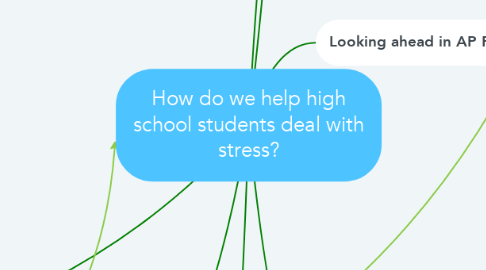How do we help high school students deal with stress?
by Mike Inumerable


1. AP Psych standard: Predict the effects of operant conditioning (e.g., positive reinforcement, negative reinforcement, punishment).
2. AP Psychology Review
2.1. AP Psych Standard: Describe the nervous system and its subdivisions and functions: — central and peripheral nervous systems; — major brain regions, lobes, and cortical areas;
2.2. AP Psych Standards: Compare and contrast various cognitive processes: — effortful versus automatic processing; — deep versus shallow processing; — focused versus divided attention. • Outline the principles that underlie effective encoding, storage, and construction of memories. • Describe strategies for memory improvement.
3. AP Psych standard: Discuss theories of stress and the effects of stress on psychological and physical well-being
3.1. General Adaptation Syndrome
3.2. Stress Appraisal: Threat or Challenge?
3.3. Type A vs. Type B Personality as it relates to stress
3.4. Stress and health/illness
3.5. Perceived stress
3.6. Emotion vs. Problem focused coping
3.7. Where stress comes from?
3.7.1. Biiological
3.7.1.1. Brain anatomy
3.7.1.2. Evolution/Fight or Flight
3.7.2. Social
3.7.2.1. Social/cultural factors
3.7.2.2. Family
3.7.2.2.1. Ap Psych standard: Explain how parenting styles influence development
3.7.2.3. Economics
3.7.3. Psychological
3.7.3.1. Learning
3.7.3.2. Trauma
4. Teenage Stressors (Students will also help to ID)
4.1. School/HW
4.2. College Prep
4.3. Sports and clubs
4.4. Social influence
4.5. Parents
4.6. Jobs
5. Stress Solutions (Students will also help to ID)
5.1. Mindfulness
5.2. Biofeedback
5.3. Exercise
5.4. More sleep
5.5. Hobbies/Activities
5.6. AP Psych Standard: Suggest how behavior modification, biofeedback, coping strategies, and selfcontrol can be used to address behavioral problems
5.7. Time/work management
6. Student skills
6.1. CCSS.ELA-LITERACY.RH.11-12.7 Integrate and evaluate multiple sources of information presented in diverse formats and media (e.g., visually, quantitatively, as well as in words) in order to address a question or solve a problem.
6.1.1. Gathering info about concepts
6.1.1.1. CCSS.ELA-LITERACY.RST.11-12.2 Determine the central ideas or conclusions of a text; summarize complex concepts, processes, or information presented in a text by paraphrasing them in simpler but still accurate terms.
6.1.2. Creating a PSA to solve the problem
6.2. CCSS.ELA-LITERACY.RST.11-12.9 Synthesize information from a range of sources (e.g., texts, experiments, simulations) into a coherent understanding of a process, phenomenon, or concept, resolving conflicting information when possible.
6.2.1. Sharing, discussing, and evaluating findings

